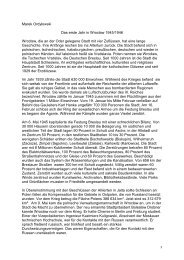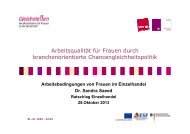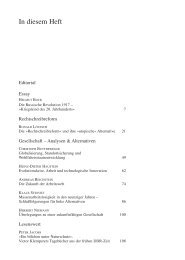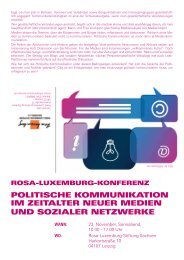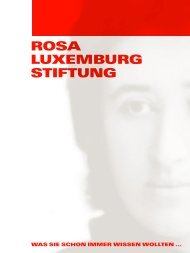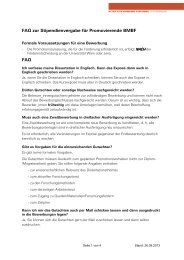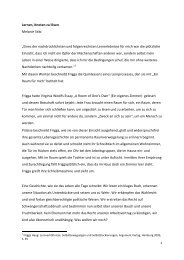The Left in Europe - Rosa-Luxemburg-Stiftung
The Left in Europe - Rosa-Luxemburg-Stiftung
The Left in Europe - Rosa-Luxemburg-Stiftung
Create successful ePaper yourself
Turn your PDF publications into a flip-book with our unique Google optimized e-Paper software.
<strong>The</strong> <strong>Left</strong> <strong>in</strong> Luxembourg<br />
Sascha Wagener<br />
<strong>The</strong> country’s economic and social situation<br />
<strong>Luxemburg</strong><br />
If <strong>in</strong> the past Luxembourg’s economy depended on the steel <strong>in</strong>dustry, today<br />
it depends on globalization and bank<strong>in</strong>g. To these vagaries of history Luxembourg<br />
owes not only its tremendous prosperity, but also its comparatively<br />
strong work<strong>in</strong>g-class movement and multicultural population. Of<br />
Luxembourg’s 483,800 <strong>in</strong>habitants those ga<strong>in</strong>fully employed number<br />
361,089, of whom 150,909 live across the border and drive <strong>in</strong> to work<br />
every day. A large proportion of those who live <strong>in</strong> Luxembourg are foreigners.<br />
Apart from the 63.1% native Luxembourgers, 13.3% have Portuguese,<br />
4.5% French, 4.3% Italian and 2.3% German passports.<br />
For a long time those who lived between the Moselle and the Ardennes<br />
eked out a meagre existence from agriculture. It was not until the discovery<br />
of large reserves of iron ore <strong>in</strong> the second half of the 19th century that<br />
th<strong>in</strong>gs began to change. <strong>The</strong> steel <strong>in</strong>dustry became the most important<br />
branch of Luxembourg’s economy, employ<strong>in</strong>g up to thirty thousand people<br />
<strong>in</strong> the 1960s and 1970s. Even today the world’s largest steel corporation<br />
Arcelor-Mittal is based <strong>in</strong> Luxembourg. When the m<strong>in</strong><strong>in</strong>g and process<strong>in</strong>g of<br />
iron ore became unproductive, Luxembourg’s government adapted the<br />
country’s economy to fill a niche <strong>in</strong> the <strong>in</strong>ternational f<strong>in</strong>ance system. <strong>The</strong><br />
<strong>Europe</strong>an Union granted the country important economic and political<br />
functions. Luxembourg became a tax haven, lur<strong>in</strong>g foreign capital <strong>in</strong>to the<br />
country with low m<strong>in</strong>imum reserves and numbered bank accounts.<br />
<strong>The</strong> budget expenditure scheduled for 2008 came to 8.5 billion euros. At<br />
the same time the national debt comes to just under ten percent of the Gross<br />
Domestic Product, which rose from 33.9 billion euros <strong>in</strong> 2006 to 36.3 <strong>in</strong><br />
2007. S<strong>in</strong>ce 1993 <strong>in</strong>flation has been constant between 2.3 and 3.4 percent.<br />
In 2007 the country’s foreign trade balance has shown a surplus of 3.6 billion<br />
euros. Luxembourg supplies 56 percent of its exports to its three<br />
neighbours, Germany, France and Belgium and another 30 percent to the<br />
rema<strong>in</strong><strong>in</strong>g EU member states. Its exports have more than doubled s<strong>in</strong>ce<br />
1993.<br />
<strong>The</strong> Luxembourg social model is based on the <strong>in</strong>stitutionalization of a<br />
social compromise and a strong trade union movement. Representatives of<br />
30



